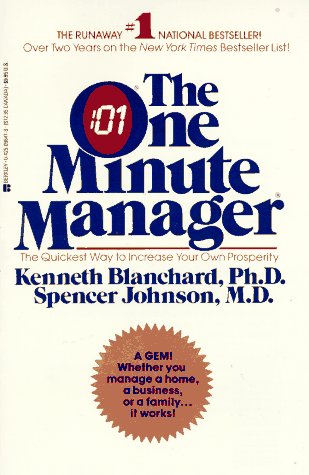The One Minute Manager Summary

13 min read ⌚
MicroSummary: The bestseller ‘The One Minute Manager’ is an easy-to-read book that presents and illustrates how to use three practical managerial techniques: setting goals, praising positive behaviors, and reprimanding negative ones. It also includes many behavioral studies and helps the reader understand how these practices can help improve communication and relationships in or out of work.
The Quickest Way to Increase Your Own Prosperity
Quick:
In how many ways can you improve your life during the next 60 seconds?
Quite a few, it seems. (And you’ll still have one second left.)
Ready to learn a few more?
“The One Minute Manager” is here just for you. Its title is no exaggeration: it aims to make you a better manager by taking just a minute of your time. (Or, better yet, three or four one-minute series).
Kenneth Blanchard and Spencer Johnson are considerate towards your schedule in one more manner. The book is fairly short, and even reading it from start to finish won’t take too much of your time.
But, as always, we can do one better.
Because we have the summary.
Who Should Read “The One Minute Manager”? And Why?
“The One Minute Manager” has been lauded by so many people that not few have deemed it a classic. One of the essential books on management. Management 101.
So, to quote American television host and media mogul Merv Griffin, – “don’t miss it.” If you’re a manager, that is. Because to everyone else, the book may seem like not much more than a very bad novel.
About Kenneth Blanchard and Spencer Johnson
Kenneth Blanchard , Ph.D., is an American trainer, writer and management and leadership expert. After receiving an MA in sociology and counseling from the Colgate University in 1963, he obtained his Ph.D. in leadership from Cornell four years later.
, Ph.D., is an American trainer, writer and management and leadership expert. After receiving an MA in sociology and counseling from the Colgate University in 1963, he obtained his Ph.D. in leadership from Cornell four years later.
He has – usually, co-authored – more than 60 books, many of which have become bestsellers. He is currently the Chief Spiritual Officer of the Ken Blanchard Companies.
Spencer Johnson , MA, was an American physician and writer, primarily known for the 43-volume ValueTales series of biographical children’s books, of which he wrote almost half.
, MA, was an American physician and writer, primarily known for the 43-volume ValueTales series of biographical children’s books, of which he wrote almost half.
He also authored the highly influential business fable, “Who Moved My Cheese?” which has sold almost 30 million copies worldwide and is translated into no less than 40 languages.
“The One Minute Manager Summary”
“The One Minute Manager” takes the form of a fable.
It tells the story of a bright young man who is looking for an effective manager.
He meets a manager after manager and he’s disappointed by all. Some are too autocratic, favoring results over people. Others are just too democratic and nice, preferring their employees over the results.
Is there not some middle ground, he wonders?
Of course, there is. And he finds it in the eponymous “One Minute Manager”.
The one-minute manager teaches the bright young man that people and results are not separated concepts. And that only people who feel good about themselves can and will produce good results.
But, how should a manager make his employees feel good about themselves and their job? In other words, how can he utilize their full potential while not using them?
Quite simply, in fact. Just by applying three one-minute methods.
First and foremost, the one-minute goal setting. Its basic idea is that 20% of your goals produce about 80% of your results. Listing them all may confuse your employees about their priorities. Listing only a few at a maximum one page will be enough.
So, select just three to six goals and communicate them to your employees. Explain to them politely and nicely that you will expect some results and that you’ll hold them accountable in their absence.
And wait for the magic to happen.
Next, comes the one-minute praising. If someone does his job good, he needs to feel deep inside that he has accomplished something. After all, if he’s held accountable for not meeting the expected goals, why shouldn’t he receive something in return for meeting them.
So, praise the employees who do a good job. The rookies love the feedbacks. And they will do an even better job next time around.
Now, don’t be fooled! Not everyone will take you seriously for the first time.
And that leads us to the third and final one-minute method: the one-minute reprimand.
Don’t overreact when someone does something bad. Just like you shouldn’t exaggerate in your praises when he does something good. Give him or her the chance to correct himself. But, be fair and tell him where and how he should do this.
So, quickly but precisely tell the worker who hasn’t met his goals what he has done wrong. And don’t let him feel as if you’re not valuing him.
Results will come to aplenty. And it will only take you three minutes of your day.
Key Lessons from “The One Minute Manager”
1. Three Minutes (and Techniques) to Greatness
2. Stop your “NIHYSOB” behavior
3. Conditioning Your Employees’ Behavior
Three Minutes (and Techniques) to Greatness
The mythical “One Minute Manager” from Blanchard’s and Johnson’s story is actually a three-minute manager. But, never mind: their point remains the same.
In a nutshell, it’s based around the idea that in a fast-paced society, you’ll have to make time stop at least three times during each day.
Once, for a minute, to set the most important three goals for your employees. The second time, to praise the ones who’ll meet them in no more than 60 seconds. And a final, third time, to reprimand those who won’t. Quickly, precisely, and politely.
Stop your “NIHYSOB” behavior
Most managers think that their job is to catch their employees doing something bad. Blanchard and Johnson call this style of managing the NIHYSOB behavior. NIHYSOB is an acronym for “Now, I have you…” – well, you know what the SOB stands for.
And that is not what your employees are.
So, in the future, try to catch them doing something good. And praise them. Feedbacks go a long way. Just as compliments.
Conditioning Your Employees’ Behavior
Even though Blanchard and Johnson claim that your employees are not SOBs, basically, the one-minute manager still feels like kind of a modernized version of Ivan Pavlov. Remember him? He thought dogs to salivate at the sound of a bell.
Blanchard and Johnson believe that this will work for your employees too. If done correctly. And gently. Maybe it will, who knows! After all, we are animals.
Like this summary? We’d Like to invite you to download our free 12 min app, for more amazing summaries and audiobooks.
“The One Minute Manager” Quotes
The One Minute Manager’s symbol is intended to remind each of us to take a minute out of our day to look into the faces of the people we manage. And to realize that they are our most important resources. Share on X Everyone is a potential winner. Some people are disguised as losers. Don’t let their appearances fool you. Share on X Take a minute! Look at your goals! Look at your performance! See if your behavior matches your goals. Share on X We are not just our behavior; we are the person managing our behavior. Share on X Goals begin behaviors; consequences maintain behaviors. Share on XOur Critical Review
“The One Minute Manager” was a sleeper hit in the 1980s. Amounting to no more than 100 pages, and going over just few practical advices, the book sold more than 10 million copies worldwide. We guess the people loved the allegorical approach and the straightforward writing, giving them an opportunity to read the whole book in the space of an hour, remembering almost all of it.
Now, who wouldn’t want that?
However, at least in the eyes of the more serious readers, the book hasn’t aged that well. Soon after becoming a bestseller, it was exposed by “The Wall Street Journal” as a heavily plagiarized version of an article by Arthur Elliott Carlisle, a University professor.
And if that wasn’t enough, in the meantime, managers started complaining that its tactics don’t really work in any other environment but the optimal. Simply put, the distraction-full fast-paced 21st century wasn’t going to allow managers to structure it in a minute or so.
So, reading “The One Minute Manager” nowadays is nothing more but a case of nostalgia. Peering into history to learn nothing about how to make your future better. And Blanchard and Johnson would be the first to agree: in 2015, they wrote “The New One Minute Manager.”
They knew the book needed an update.
But, that’s a topic for another summary.
| NEW / Extended | The One Minute Manager Summary
The author believes these new management techniques will make you a more efficient manager able to get better results, taking better advantage of your time and make your employees more competent.
Also, these techniques can make your employees use the same approach and a chain of positive feedback and effective communication, reaching your entire organization.
Start Applying The ‘One Minute Management’ Right Now
You can start using ‘minute-management’ techniques immediately. You do not have to wait until you fully understand them and know exactly how they should be applied in your organization.
In fact, the best way to become familiar with and understand how they can work for you is to start using them now.
Starting to work with them will be the most effective way to adapt them to your organization, and once you’ve taught others about how they work, they can help you make the process regular and effective.
A manager needs to be constantly evaluating and improving their staff and procedures, and the ‘minute-management’ program facilitates this process.
You will learn how to develop effective goals for yourself and your team that will ensure that your entire organization is always growing.
These goals will give you a quantitative way of measuring the success of your new techniques.
Following this program, you will learn the importance of praising those who are delivering good results within your team, who will then develop to continue the good work and merit recognition for their accomplishments.
And when someone makes a mistake, you will also be able to express your feelings about it, but still guaranteeing that this person is valued by the company.
This will allow your team members to use their mistakes as a learning experience to help them improve as employees.
The main purpose of the three tools ‘minute managers’ use is to create effective and constant communication with those around them.
Better communication is always a positive goal and will help you become more understanding. The sooner everyone adopts the idea, the faster you’ll see the results.
Establishing Goals
One of the first tools you should use in the ‘minute-management’ method is the establishment of meaningful ‘minutes goals’.
This practice allows the manager and employee to be in sync with the employee’s role and what must be done to succeed.
As a manager, this will allow you to clearly define the responsibility of your employees and measure their success.
The idea is not to dictate the goals of the employees but to discuss their tasks together and help them develop their own goals.
Each goal should be briefly described with deadlines. These descriptions should have no more than one or two paragraphs and should not take more than one minute to read.
Each ‘minute-goal’ should be accessible to employees so they can refer to it whenever they need it. They can then verify that their attitudes are aligned with their goals.
If they are not, they can make necessary adjustments to get back on track without needing to be reminded of it.
That makes employees effectively manage themselves to a certain degree that is beneficial to both.
Your employees should also not need many goals to achieve.
Once you explain your desired roles and results step-by-step, your primary responsibilities will encompass between three and five goals in all.
You will then be able to measure success by these goals because you will both understand them.
When you set effective goals and communicate to your employees exactly what is expected of them, they will not be surprised or disoriented.
You may need to offer some guidance at times, but this method will allow them to stay on track and make necessary adjustments to achieve their goals.
Give Feedbacks And Praise When You Need
The next important tool is the “praise-minute”.
As seen in the previous topic, people are much more likely to understand their purposes and pursue business goals when you teach them how to set goals and measure their actions appropriately.
But the best way for them to know they are making progress is to communicate this to them in a clear way.
As soon as the mistake happens, meet with your staff to confirm the facts of the incident and explain what happened.
Tell them specifically what is wrong, so that it is absolutely clear. Then tell the person how you feel about the mistake – that it bothers or upsets you – and how it can have a negative impact.
Then you can pause the moment so that the person understands the gravity of the situation and the mistakes. The next part of the rebuke will help end the discussion positively.
Let your employees know that they are better than the mistake they made and that you still believe in their potential.
Make it clear that you are still confident in their abilities and trust them to correct the mistake. Also, let them know that you want them to be successful and that you support them.
Once the rebuke is over, so is the problem. Reprimands are not exactly positive experiences for you or your employee, but following this formula helps make it a meaningful learning opportunity.
 Do Not Wait For Official Results Or Reports To Take Action
Do Not Wait For Official Results Or Reports To Take Action
In every aspect of the ‘management-minute’ technique, the key is to act immediately to achieve the desired results.
If you do not set goals at once, employees will not know what you want from them or how they need to achieve results, which is a waste of time.
Letting an employee’s actions, whether good or bad, accumulate for a long time before recognizing them can often generate negative behavior and keep them from reaching their full potential.
Acting quickly prevents disasters and encourages success.
If you compliment an employee long after a deserving attitude, he/she may not understand what specific behavior you want him/her to continue.
There will then be a disconnection between what he/she did and why it was good, and the praise will not be as effective.
By praising immediately, you guide your employees step by step on the path you want.
An example is when children learn to speak. In the beginning, you praise them for simply making sounds with their mouth.
Then the learning process continues, you stop applauding the sounds and keep the accolades for words formed. Over time, the child is already speaking whole sentences.
If you had waited until the child spoke whole sentences to compliment them, it would have taken much longer for her to succeed.
So immediate praise accelerates the learning process and employee improvements.
The same thing happens with regards to rebuke. If you let issues develop until you have a list of things to say about what an employee has done wrong, the experience can quickly become disruptive.
Even if it happened smoothly, it would be very discouraging for an employee, and he may have trouble identifying exactly what he did wrong because it all happened some time ago.
Alternatively, immediate reprimand maintains negative feedbacks in small doses and helps guide employee behavior, preventing further mistakes from occurring.
Worry About People And Results To Be An Effective Manager
Management can be a confusing topic because there are a lot of conflicting points of view about what works and what does not.
No two managers are exactly alike, but many follow similar plans to achieve their goals.
Some people believe that management takes care of numbers and results achieved, even if it means being tough on their employees and making them unhappy.
While some managers may find this effective, their employees are more likely to disagree.
This type of manager is not communicating competently or even caring for his team.
Another common type of manager is the kind and supportive guy who is so concerned about people that the numbers and results are neglected.
Profit suffers because the manager does not want to propel people into not making things difficult for them.
While these managers certainly have happier employees who can defend the method, their superiors, who are probably more concerned with numbers, have a different opinion.
If a business is not profiting, then the management techniques used probably need to be improved.
Each of these different managers is doing something right, but also letting something important happen.
The best managers can strike a balance between caring for people and looking for results, which provides the balance needed to succeed in both categories.
By caring for people and demonstrating that they are important, a manager is empowering and developing them to be more effective members of the organization, making them responsible for important issues.
Those who know what’s important to you will take your priorities seriously. The results you want to achieve will be important goals for them as well.
These employees will become assets that increase the value of the company and improve profits and results every time they are measured.
When people feel they are important, they work hard and better to achieve meaningful results.

Final Notes:
‘Minute management’ means setting goals, praising achievements and positive behaviors, and rebuking employees when they make mistakes.
Applying these three excellent management techniques, you can develop a culture focused on the success of the results, which will reach each level of your organization.
The trick is to remember that you are dealing with people and that they need to feel they are important to you.
But at the same time, results are equally important, and your people must understand that too. These techniques will help you communicate this importance to your employees.
And the same goes for your other relationships and interactions.
You can not only use these methods in your home and personal life, but you can also find out that other people with whom you shared these techniques are doing the same.
Goals, reprimands, and praise are powerful behavioral motivators that can help you and those around you develop positive habits.
These habits keep us constantly aware of what is most important and how we need to behave to achieve it.
You may be surprised at how much of a difference these methods can generate.
This is one of the most effective and cost-effective ways to develop your people and processes.
Investing time and effort in your relationships can make you a communicator and a more effective manager.


 Do Not Wait For Official Results Or Reports To Take Action
Do Not Wait For Official Results Or Reports To Take Action




